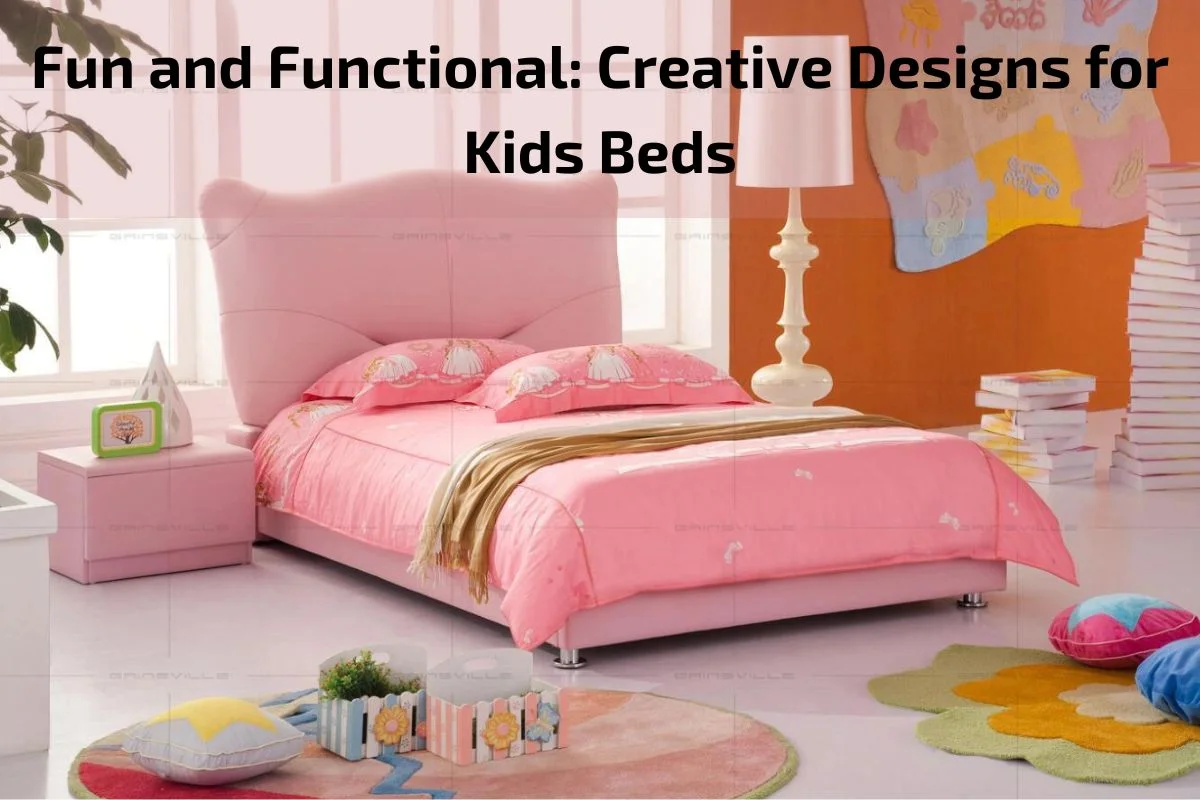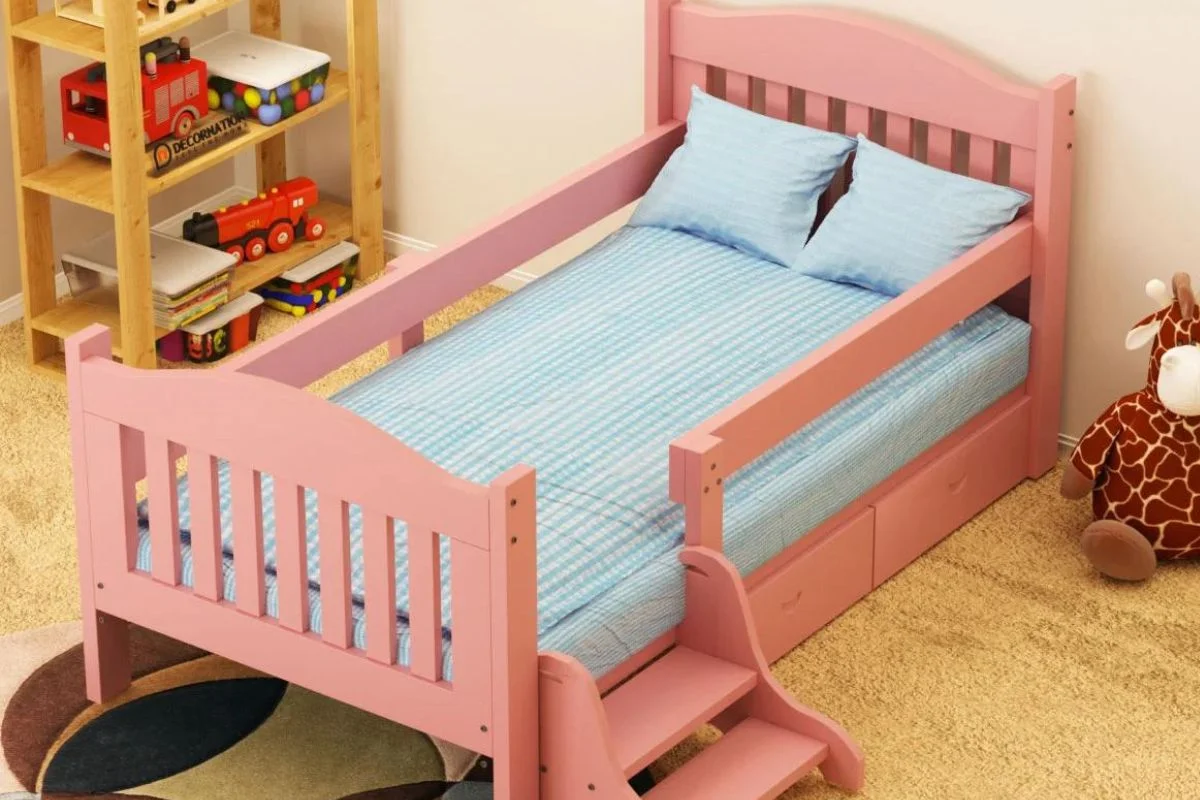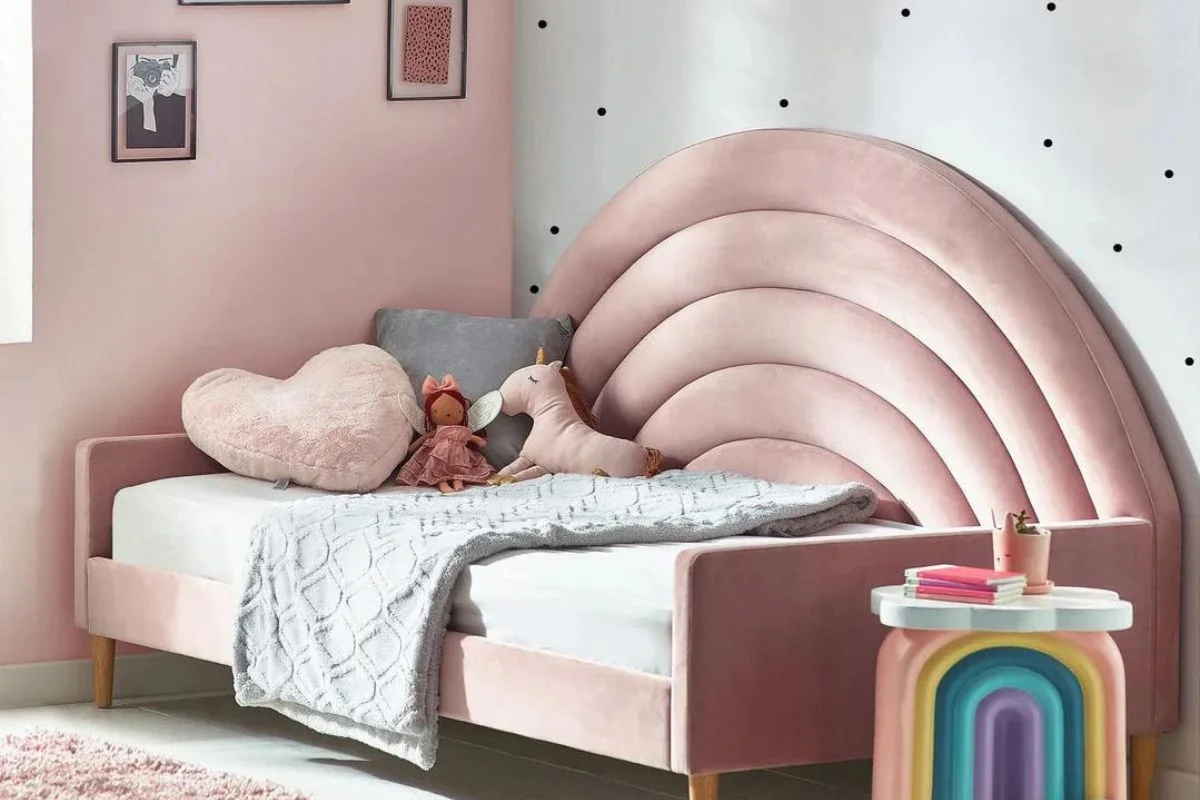Fun and Functional: Creative Designs for Kids Beds
When it comes to furnishing a child’s bedroom, creativity and functionality go hand in hand. Kids beds are not just a place to sleep; they serve as the centerpiece of the room, setting the tone for the entire space. With a wide range of designs and options available, parents have the opportunity to choose a bed that not only meets their child’s practical needs but also reflects their personality and interests.
In this guide, we’ll explore the world of kids beds and showcase some of the most creative and functional designs available. From whimsical themes and innovative storage solutions to versatile bunk beds and loft beds, there’s a bed to suit every child’s style and space constraints.
Join us as we dive into the exciting realm of kids beds, where imagination knows no bounds and practicality meets playfulness. Whether you’re looking to create a cozy sleep space for a toddler or a dreamy retreat for a teenager, these creative bed designs are sure to inspire you to transform your child’s bedroom into a space they’ll love to call their own.
Importance of the bed in a child’s room
The bed holds a pivotal role in a child’s room, serving as more than just a piece of furniture for sleep. Its significance extends far beyond its functional purpose, encompassing aspects of safety, comfort, and even emotional security. Here are several reasons why the bed is of utmost importance in a child’s room:
Sleep Quality: The bed directly impacts the quality of a child’s sleep, which is crucial for their physical and cognitive development. A comfortable and supportive bed promotes restful sleep, aiding in growth, learning, and overall well-being.
Safe Haven: For many children, their bed represents a safe and comforting space within their room. It serves as a retreat where they can seek solace, unwind, and recharge after a busy day of exploration and play.
Personalization and Expression: The bed often reflects a child’s personality, interests, and individuality. Whether adorned with favorite cartoon characters, vibrant colors, or themed designs, it becomes a canvas for self-expression and creativity, allowing children to make their space uniquely theirs.
Routine and Structure: Establishing a bedtime routine is essential for a child’s health and development. The bed serves as the centerpiece of this routine, signaling the transition from daytime activities to restful sleep. Consistent bedtime rituals centered around the bed can promote relaxation and help children unwind before sleep.
Bonding and Storytelling: The bed holds significance beyond its function as a sleeping surface; it also serves as a platform for bonding and storytelling. Bedtime stories shared between parents and children create lasting memories and strengthen familial bonds. Additionally, the bed often becomes a stage for imaginative play, where children enact fantastical adventures and create their own narratives.
Growing with the Child: As children grow and transition through various stages of development, their bed evolves alongside them. From the crib in infancy to the transition to a toddler bed and eventually to a full-sized bed, each milestone represents a new chapter in the child’s life. The bed adapts to accommodate their changing needs, providing a sense of continuity and stability amidst growth and transition.
Definition and Significance of Kids Beds
Definition: Kids beds refer to specialized sleeping furniture designed specifically for children, tailored to meet their unique needs and preferences. These beds come in various sizes, styles, and configurations, catering to children of different ages, interests, and space requirements.
Significance:
Comfort and Support: Kids beds are crafted with children’s comfort and support in mind. They feature materials and designs suited to their growing bodies, providing adequate support for healthy sleep and proper development.
Safety: Safety is paramount when it comes to kids beds. They are constructed with safety features such as rounded edges, sturdy frames, and low heights to prevent accidents and injuries, ensuring a secure sleeping environment for children.
Promoting Independence: Transitioning to a “big kid” bed is a significant milestone for children, marking a step towards independence. Kids beds are designed to facilitate this transition smoothly, offering age-appropriate features that empower children to take ownership of their sleep space.
Personalization and Expression: Kids beds often come in a variety of fun and creative designs, allowing children to express their personalities and interests. Whether themed after favorite characters, sports, or hobbies, these beds serve as a canvas for self-expression and imagination.
Creating a Sleep Routine: Establishing a consistent sleep routine is essential for children’s health and well-being. Kids beds play a vital role in this routine, providing a designated space where children can wind down, relax, and prepare for sleep, promoting healthy sleep habits.
Fostering Emotional Security: The bed serves as a comforting and familiar space within the child’s room, offering a sense of security and stability. It becomes a sanctuary where children can retreat for rest and relaxation, fostering emotional well-being and a sense of belonging.
Supporting Growth and Development: As children grow and develop, their sleep needs evolve. Kids beds are designed to accommodate these changes, offering adjustable features and configurations that support children’s growth and development through various stages of childhood.
Types of Kids Beds
Standard Beds: These are basic beds suitable for children of all ages. They come in various sizes such as twin beds (single) or full beds (double), providing ample space for comfortable sleep.
Bunk Beds: Ideal for shared bedrooms or maximizing space, bunk beds feature one bed frame stacked atop another. They are popular among siblings or for hosting sleepovers, offering two sleeping surfaces while occupying the floor space of a single bed.
Loft Beds: Loft beds elevate the sleeping surface, utilizing the space underneath for other purposes such as a desk, play area, or storage. They are excellent for optimizing space in small rooms or creating multifunctional bedroom layouts.
Theme Beds: These beds are designed around specific themes or interests, appealing to children’s imagination and preferences. Examples include car-shaped beds, princess castle beds, treehouse beds, and spaceship beds, transforming the sleeping experience into a magical adventure.
Functional Beds: Functional beds offer additional features or storage solutions to maximize utility in a child’s room. Examples include trundle beds with pull-out mattresses for guests, captain’s beds with built-in drawers for clothing storage, and platform beds with integrated shelving or cubbies.
Convertible Beds: Convertible beds are designed to adapt to a child’s changing needs over time. They can transition from a crib to a toddler bed, and later into a full-sized bed, providing long-term value and versatility for growing children.
Canopy Beds: Canopy beds feature a decorative fabric canopy suspended above the bed frame, creating a cozy and elegant sleeping space reminiscent of fairy tales or royal chambers. They add a touch of whimsy and sophistication to a child’s bedroom decor.
Daybeds: Daybeds serve dual functions as both a sofa and a bed, making them versatile options for guest rooms or multipurpose spaces. They offer a comfortable seating area during the day and a cozy bed for sleeping at night.
Futons: Futons are lightweight and space-saving beds that can be easily folded into a sofa or reclined into a flat sleeping surface. They are practical choices for children’s rooms with limited space or for accommodating overnight guests.
Adjustable Beds: Adjustable beds feature mechanisms that allow the mattress to be raised or lowered to different positions for enhanced comfort and support. They are beneficial for children with medical conditions or those who prefer customizable sleeping positions.
Tips for Decorating with Kids Beds
Decorating a child’s bedroom involves more than just selecting a bed; it’s about creating a space that reflects their personality, interests, and provides a comfortable environment for rest and play. Here are some tips for decorating with kids beds:
Choose a Theme: Coordinate the bed’s design with a theme that resonates with your child’s interests. Whether it’s dinosaurs, princesses, outer space, or sports, selecting a cohesive theme can tie the room together and inspire further decoration.
Coordinate Bedding: Select bedding that complements the bed’s design and the room’s color scheme. Look for bedding sets featuring patterns or characters that align with the chosen theme, adding visual interest and personality to the space.
Add Decorative Accents: Enhance the bed’s aesthetic appeal with decorative accents such as throw pillows, plush toys, or themed wall decals. These small touches can inject personality and charm into the room while creating a cozy and inviting atmosphere.
Maximize Storage: Opt for beds with built-in storage solutions, such as drawers or shelves, to maximize space and keep the room organized. Utilize under-bed storage containers or baskets to store toys, books, and other essentials, minimizing clutter and promoting a tidy environment.
Create a Cozy Nook: Arrange the bed in a cozy corner of the room, surrounded by soft rugs, cushions, and curtains to create a snug and inviting sleeping nook. Incorporate string lights or a canopy to add a magical touch and encourage relaxation and comfort.
Personalize the Space: Encourage your child to personalize their sleeping area with their artwork, photos, or cherished possessions. Display their creations on the walls, bedside tables, or shelves to foster a sense of ownership and pride in their space.
Consider Safety: Ensure the bed is positioned away from windows, electrical outlets, and other potential hazards. Secure furniture and decor items to the wall to prevent tipping and accidents, prioritizing safety without compromising style.
Create a Reading Corner: Incorporate a cozy reading corner near the bed with a comfortable chair or bean bag, a bookshelf stocked with age-appropriate books, and adequate lighting. Encourage your child to unwind before bedtime with a bedtime story or quiet reading time.
Encourage Play: Designate a play area within the room where your child can engage in imaginative play and creative activities. Consider incorporating a play tent, dress-up corner, or art station to foster creativity and active play.
Involve Your Child: Finally, involve your child in the decorating process by soliciting their input and incorporating their preferences into the design. By empowering them to contribute to the creation of their space, you can cultivate a sense of ownership and pride in their bedroom.
Benefits of Kids Beds
Promote Restful Sleep: Kids beds are designed with comfort and support in mind, providing children with a dedicated space to rest and recharge. The proper mattress and bedding can contribute to better sleep quality, ensuring children wake up refreshed and ready to tackle the day ahead.
Encourage Independence: Transitioning to a kids bed marks a significant milestone in a child’s development, fostering a sense of independence and autonomy. Having their own bed allows children to take ownership of their sleeping space, promoting confidence and self-reliance.
Support Physical Development: Kids beds are tailored to the unique needs of growing children, offering appropriate support for their developing bodies. A supportive mattress and ergonomic design can help promote healthy spinal alignment and posture, supporting overall physical development.
Enhance Safety: Kids beds are equipped with safety features such as low heights, rounded edges, and sturdy construction to minimize the risk of accidents and injuries. By providing a secure sleeping environment, parents can have peace of mind knowing their children are safe while they sleep.
Promote Healthy Sleep Habits: Establishing a consistent bedtime routine is essential for children’s sleep health. Having a designated kids bed encourages the development of healthy sleep habits, signaling to children that it’s time to unwind and prepare for sleep.
Facilitate Bonding: Kids beds serve as a focal point for bedtime routines, providing opportunities for parents and children to bond through activities such as reading bedtime stories or sharing nightly rituals. These shared experiences strengthen the parent-child bond and create lasting memories.
Encourage Creativity and Imagination: Many kids beds feature fun and whimsical designs that spark children’s imagination and creativity. Whether it’s a themed bed shaped like a castle or a spaceship, these imaginative designs inspire play and storytelling, turning bedtime into an adventure.
Maximize Space: Kids beds come in a variety of configurations, including bunk beds, loft beds, and trundle beds, that maximize space in small bedrooms or shared spaces. These space-saving designs allow siblings to comfortably share a room or create additional play or storage space underneath the bed.
Personalization: Kids beds offer opportunities for personalization, allowing children to choose designs, colors, and themes that reflect their interests and personality. This customization fosters a sense of ownership and pride in their sleeping space, making bedtime more enjoyable.
Transition to Adulthood: As children grow, their needs and preferences evolve. Kids beds that transition from crib to toddler bed to full-sized bed adapt to these changes, providing long-term value and versatility as children transition into adolescence and adulthood.
Maintenance and Care Tips for Kids Beds
Proper maintenance and care of kids beds are essential to ensure their longevity, safety, and continued comfort. Here are some tips to keep your child’s bed in excellent condition:
Regular Cleaning: Dust and debris can accumulate on the bed frame, mattress, and bedding over time. Regularly vacuum or wipe down the bed frame with a damp cloth to remove dirt and dust. Wash bedding, including sheets, pillowcases, and comforters, according to manufacturer guidelines.
Rotate the Mattress: To prevent uneven wear and sagging, rotate the mattress periodically. Consult the manufacturer’s instructions for specific guidelines on rotating and flipping the mattress to maintain its shape and support.
Check for Damage: Regularly inspect the bed frame, mattress, and bedding for signs of damage or wear and tear. Look for loose screws or bolts, cracked or splintered wood, and sagging mattress springs. Address any issues promptly to prevent further damage and ensure the bed remains safe for use.
Address Stains Promptly: Accidents happen, especially in children’s bedrooms. If spills or stains occur on the mattress or bedding, treat them promptly to prevent permanent damage. Use mild soap and water or a mattress stain remover to clean stains, following manufacturer instructions carefully.
Protect the Mattress: Consider using a mattress protector or waterproof mattress pad to shield the mattress from spills, accidents, and allergens. These protective covers are easy to remove and wash, prolonging the life of the mattress and maintaining a hygienic sleeping environment.
Secure Bedding and Accessories: Ensure that bedding, pillows, and decorative accessories are securely attached to the bed frame to prevent them from falling or posing a safety hazard. Avoid placing heavy or sharp objects near the bed that could potentially cause injury if knocked over.
Monitor Weight Limits: Be mindful of weight limits specified by the manufacturer, especially for bunk beds and loft beds. Avoid exceeding these limits to prevent structural damage and ensure the bed remains stable and safe for use.
Follow Manufacturer Guidelines: Always follow the manufacturer’s instructions for assembly, maintenance, and care of the bed. Refer to the product manual or contact the manufacturer for specific recommendations on cleaning, maintenance, and safety precautions.
Teach Children Proper Care: Educate children about the importance of taking care of their bed and belongings. Encourage them to make their bed daily, avoid jumping on the mattress, and notify an adult if they notice any damage or issues with the bed.
Schedule Professional Inspection: Consider scheduling a professional inspection of the bed frame and mattress annually to identify any potential issues and ensure continued safety and durability. A trained technician can assess the condition of the bed and make recommendations for repairs or replacements as needed
Conclusion
In conclusion, kids beds play a crucial role in creating a comfortable, safe, and nurturing sleep environment for children. From promoting restful sleep to fostering independence and creativity, these beds offer a multitude of benefits that contribute to children’s overall well-being and development.






0 comments